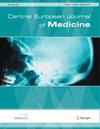Agreement between manual and automated measurements of simple QRS/T angle
引用次数: 1
Abstract
The spatial QRS/T angle (QRS/T) has been identified as a strong and independent predictor of adverse cardiac events. QRS/T can be determined from the electrocardiogram (ECG) by matrix transformation methods or formula which uses a combination of net QRS and T-wave amplitudes (QRS/Tsimple). Amplitudes can be measured automatically by using dedicated software (QRS/Tauto) or can be manually measured on a computer screen (QRS/Tmanual). This latter method allows analysis of QRS/T, when digital ECGs are not available. The aim of the study was to determine the agreement in the measurements between automatically derived QRS and T amplitudes and manually measured on the computer screen amplitudes. The relative error of the QRS/T between the two methods was estimated in 73 patients. In the case of QRS/Tmanual the inter-observer as well as intra-observer variability was estimated. The relative error between QRS/Tauto vs. QRS/Tmanual was 3.51%. Inter-observer and intra-observer variability of the QRS/Tmanual was 1.19% and 1.18% respectively. Manual measurement of the QRS/T is reliable, however, the predictive value of this parameter should be tested in clinical trials, before QRS/Tmanual can be considered a useful tool in clinical practice or retrospective studies.简单QRS/T角的手动和自动测量之间的一致性
空间QRS/T角(QRS/T)已被确定为心脏不良事件的一个强大而独立的预测因子。QRS/T可以通过矩阵变换方法或结合净QRS和T波振幅的公式(QRS/Tsimple)从心电图(ECG)中确定。振幅可以通过使用专用软件(QRS/Tauto)自动测量,也可以在计算机屏幕上手动测量(QRS/Tmanual)。当数字心电图不可用时,后一种方法允许分析QRS/T。该研究的目的是确定自动获得的QRS和T振幅与在计算机屏幕上手动测量的振幅之间的一致性。在73例患者中估计了两种方法的QRS/T的相对误差。在QRS/Tmanual的情况下,估计了观察者之间和观察者内部的可变性。QRS/Tauto与QRS/Tmanual的相对误差为3.51%。QRS/Tmanual的观察者间和观察者内变异率分别为1.19%和1.18%。人工测量QRS/T是可靠的,然而,在QRS/Tmanual被认为是临床实践或回顾性研究的有用工具之前,该参数的预测价值应在临床试验中进行测试。
本文章由计算机程序翻译,如有差异,请以英文原文为准。
求助全文
约1分钟内获得全文
求助全文

 求助内容:
求助内容: 应助结果提醒方式:
应助结果提醒方式:


